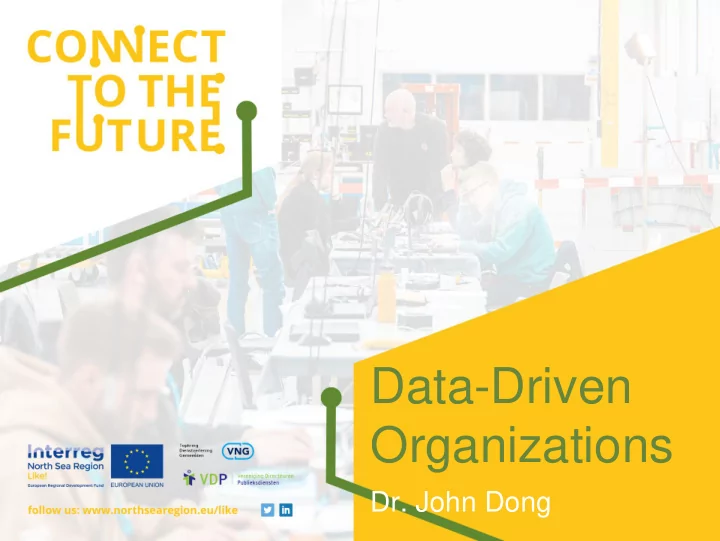

Data-Driven Organizations Dr. John Dong
About Me • Associate professor at University of Groningen • Research fellow of Groningen Digital Business Center (GDBC) • Director of master programme in change management • Director of digital business focus area • PhD in information systems • Senior editor of Information Technology & People • Associate editor of Information & Management • Chair of big data analytics track at Wuhan International Conference on E-Business (WHICEB) ...
Private Sectors DATA!
Big Data
What Is It
Analytics
E-Government
E-Government 2.0 • From digitization/digitalization to digital transformation • The more quality and accurate data is available, the better the public decisions • The faster data is available, the faster public decisions
Big Data Analytics
Unbalanced Speed • Technology evolves and is adopted very rapidly, but policymaking practices change slowly • Primary focus on creating and gathering, rather than using • Policymaking concerns the long term and cannot adapt to the speed of data gathering • The speed of policymaking is constrained by public administration and political dynamics
Shortage of Resources • Government is often lack of sufficient resources and investments in big data analytics • Strong conservative culture against change • Shortage of financial investment • Without top management support • Lack of qualified skills, internally and externally • Zero tolerance for experimentation and failure
People, Not Technology • The most challenging part is transforming people, rather than adopting new technology • Difficult in integrating big data analytics with current work practices • Fear of being replaced, though it is useful • Passive, active and aggressive resistance behavior • Knowledge gap between administrative and technical staffs (translation is needed)
Chase of Size • How bigger doesn’t always mean better in policymaking • Substantial representativeness problems • More “noise” than “meaning” • Better is not objective, but context-specific
Privacy • The privacy dilemma: If we speak of data it needs to mirror reality as closely as possible; in order to avoid privacy issues, we need to distort data • Privacy essentially challenges the assumption on accuracy of big data • Privacy requires more sophisticated technical and analytical approaches than what we have now
A Framework
Solutions • Investing sufficient resources • Gaining support from top management • Developing systematic data-centric strategies • Offering training and transition plans • Accumulating a diverse, qualified workforce • Embedding data in work practices • Fostering a changing, innovative culture • Holding reasonable risk tolerance
• The city of Houston is ranked the 4th Case in the list of top 10 largest metro areas in the U.S. with a population of 7 million people, and the 30th largest economy in the world with annual gross metropolitan product (GMP) of 500 billion USD 311 on- • In February 1997, The U.S. Federal demand Communication Commission (PCC) services created the 311 number for non- emergency police and government service with the goal of relieving congestion on the emergency number 911 • Many cities, including Houston, since have adopted 311 as a way of centralizing public service issues for city government to streamline processes and more effectively respond to their citizens’ service and information needs
• Case Sufficient resource investment: The city has significantly invested in enterprise systems, cloud computing, big data analytics and IT workforce, supporting transition from a call center to 360 self- service channels allowing citizen 311 on- engagement demand • Data-driven strategic vision: Mayor Annise Parker outlined strategic vision services of ”data - driven government” in 2010 and created the Performance Improvement Division and Portal in 2011 for continuous improvement of public services • Integration of data and work: Houston 311 localizes big data analytics use at the department level, making leaders and departments more responsive to the need for citizens’ needs and some department to achieve new levels of operational flexibility and efficiency
• Case Big data analytics empowers the government for self-organization: monitoring emerging trends across 2 million calls and to gain new insights into the potential cost-saving efficiency for 22 departments 311 on- • Big data analytics enables effective demand service process: 1300 → 450 FTEs services for 1.4 → 2.2 million citizens; quick decisions on effective solutions on the on-demand services delivery • Big data analytics also moves citizens from physical channels to digital channels: 311 hotline is more costly than website or mobile app in digitization and accuracy of data collection → annual cost savings of 500,000 USD
Q&As Note: it is “ml”, not “ nl ” Blog: johndong.ml Email: john.dong@rug.nl
Recommend
More recommend